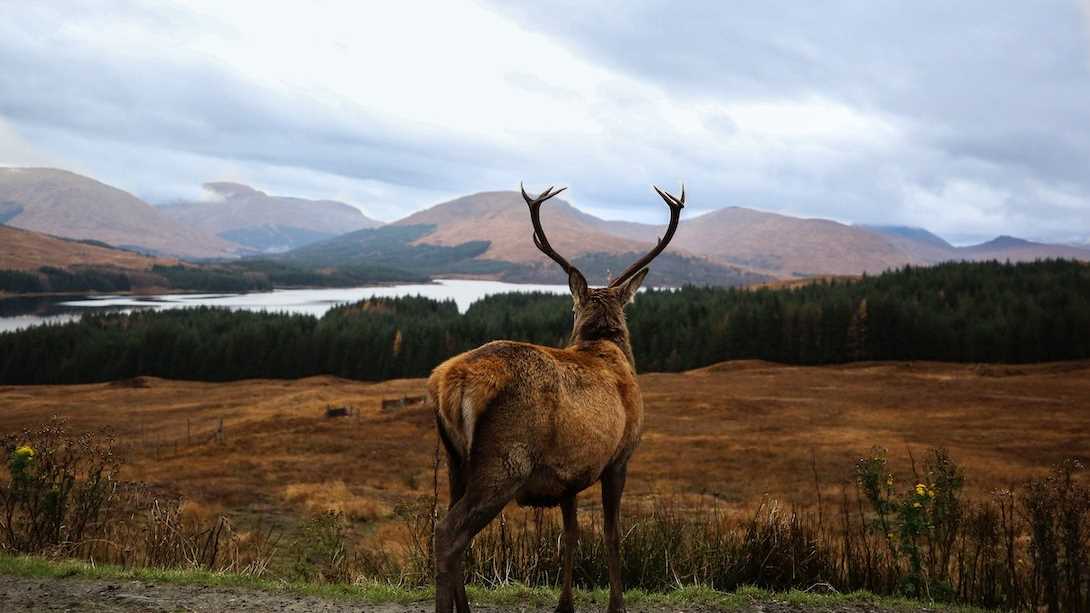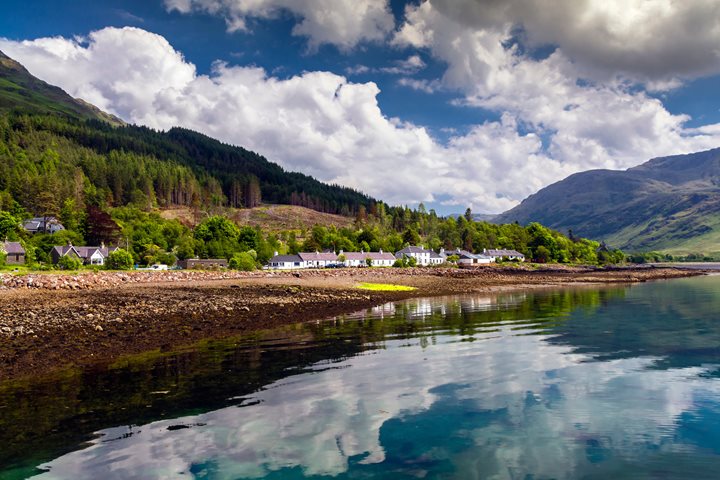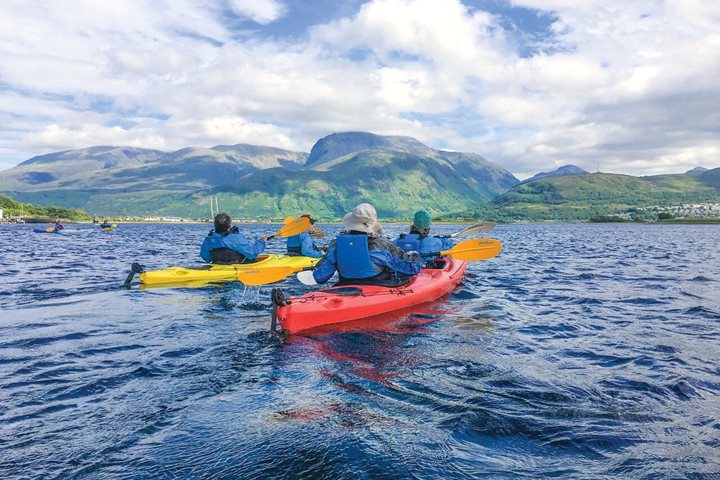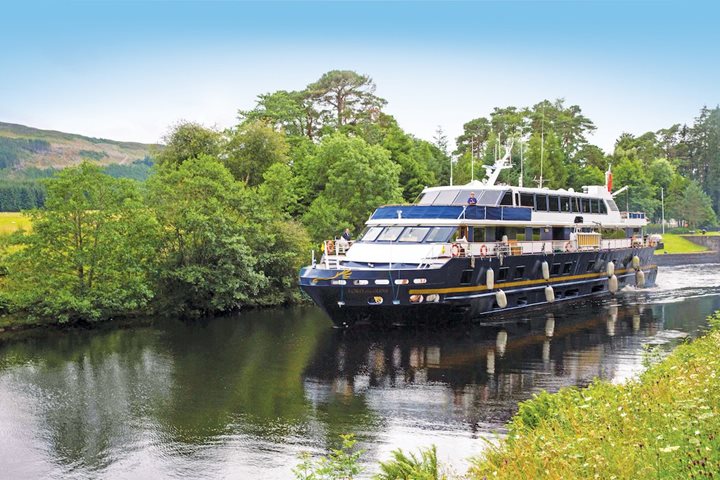To the uninitiated, Scotland’s wildlife amounts to the sheep that outnumber people and those shaggy Highland cows seen grazing in grassy meadows. (Gullible travelers might also seek out the wild haggis but, alas, will never be rewarded with a sighting of this mythical beastie). However, if you know where to look, there’s actually an abundance of other fascinating species to spot in this storied land.
Shaggy Highland cows are a common sight in the countryside.
VIEW SCOTLAND ITINERARY >
To shed light on Caledonia’s unknown wildlife lexicon, we called on naturalist Ella Potts who has lived and worked in the Hebrides for a decade and is very familiar with its incredible wildlife. A marine biologist with a background in whale conservation and research, she has long been fascinated with our oceans’ largest apex predators and she approaches exploration with radiant positivity and an activist mindset. When not scanning the seas for life from the bows of our ships, Potts has been busying herself in the world of wildlife filmmaking, to bring the secret lives of the animals of our oceans to a wider audience.
Our unique Scottish expedition cuts through the heart of this verdant country before venturing to seldom-seen wild islands, creating a rare experience and the chance to observe the wealth of animals on land and in the sea.
Wildlife Along the Caledonian Canal
Lined with forests of old oaks, conifers, and Scots pines, the Caledonian Canal and its surroundings are habitats for an array of woodland creatures and birdlife.
The woodland-dwelling European pine marten is a stealthy, acrobatic hunter.
After a fascinating day delving into Scotland’s long history at the storied battlefield of Culloden and the Bronze Age standing stones at Clava Cairns, cruise Loch Ness on the lookout for its most famous resident. However, otters are more likely to be spotted than Nessie. Remember to scan the loch’s shores for a glimpse of red deer, red squirrels, and weasel-like pine martens as well as birds including golden eagles and black grouse.
Scotland supports the largest population of red deer in all of Europe.
The next day while kayaking on Loch Linnhe, be on the lookout for common and grey seals, oystercatchers, mergansers, guillemots, shags, and cormorants. Harbor porpoises, otters, and golden and white-tailed eagles are also possible sightings. Those who choose to venture to scenic Glenfinnan might be able to spot red or roe deer, fox, badger, mink, and the elusive Scottish wildcat, which can be twice as large as a domestic feline. On a walk in the woods, look up and listen for the calls of the willow warbler, meadow pippit, whinchat, and chaffinch.
Marine Life in the Sea of the Hebrides
A huge explosion of wildlife awaits when Lord of the Glens enters the waters along the west coast of Scotland—a hotspot for marine mammals in Europe, according to Potts. The Sea of the Hebrides has “one of the highest abundances of harbor porpoises in all of Europe and probably all of the world.” She reports that there are 24 recorded species of cetaceans here, with one of the most commonly sighted being the minke whale. Averaging 32 feet in length, they’re small for a whale and “very beautiful with a long sloping back, dorsal fin, and lovely blue-gray color,” she says. Often thought of as shy, minke whales can show curious tendencies, often approaching our ship when it’s still, says Potts.
It's common for Risso's dolphins to sport lots of scars, the result of teeth raking between dolphins and encounters with their favorite food, squid.
Several species of dolphins including bottlenose and Risso’s frequent these waters but the common dolphin is the most regularly sighted. This wasn’t always the case. “Sightings used to be very infrequent but now they are probably the most abundant cetacean in the Hebrides, seen every month of the year," explains Potts. "It’s possible that they are emblematic of a slightly changing ocean. You get big mixed pods of adults and juveniles in the summertime. They’re hunting fish but they also make time to play with boats."
On from Oban, we navigate up the Sound of Mull to visit Duart Castle, which is part of the Hebridean Whale Trail. From the battlements, scan the sea for whales, dolphins, and porpoises. In the waters around Eigg and Rum, grey and common seals, minke whales, several species of dolphin, basking sharks, harbor porpoises, and even a rare humpback whale can show themselves; while the sea around Skye is home seasonally to basking sharks, minke whales, and porpoises.
Minke whales are the smallest baleen whale found in U.K. waters.
A rare sight would be Jonh Coe and Aquarius, the last two members of a pod of orcas that has lived in these waters for decades. Potts explains that they are both male and infertile due to high levels of PCBs. These enormous cetaceans have a real affinity with the Sea of the Hebrides around the Isle of Mull, which is one of the only places in the world to see the final representatives of this ecotype. There is reason to be hopeful though. "There is a pod of fish- and seal-eating orca that live farther north around Shetland, and it’s possible that as we lose the last of our mammal-eating ecotype, we may see more of these in the Hebrides," says Potts. They feed “slightly down the tropic system”–mostly on fish rather than mammals—so they are less affected by human pollution.
Scotland Birdlife Abounds
Birders will be amazed by the abundant birdlife in and around the Sea of the Hebrides. Golden eagles can be found in Mull’s Celtic rainforest and the island is home to the highest density of white-tailed eagles in the U.K. Meanwhile, 40 percent of the world’s population of Manx shearwaters live on Rum. A cousin of the albatross, they got their name from their ability to shear very close to the surface of the water.
The top predator in the Scottish countryside, the majestic golden eagle can be seen soaring high up in the sky.
Gannets are another populous sea bird around these waters. In what Potts calls an “amazing spectacle of nature,” they “dive into the water at the speed of a car on the motorway,” about 60 miles per hour. One of their adaptations to achieve such extreme speed, she explains, is that they "dislocate their shoulders on entry to the water, giving them the perfect streamlined shape, like an arrow hitting into a target."
Kittiwakes, razorbills, and guillemots are also regularly sighted. And on Iona, there's a good chance of hearing, and possibly even seeing, the endangered corncrake.
A flock of Manx shearwaters in flight.
Because the water is shallow in this area, averaging just above 160 feet deep, the abundant fish are easy targets. Potts reports that it is not unlikely to “see big rafts of seabirds feeding together with whales, common dolphins, and harbor porpoises poking up in the middle.” Just another glorious day in the Scottish isles!
So, now you know that in addition to castles, bagpipes, and whisky, Scotland should also be recognized for its exciting wildlife. Just don’t fall for an invitation to follow the trail of a haggis!




